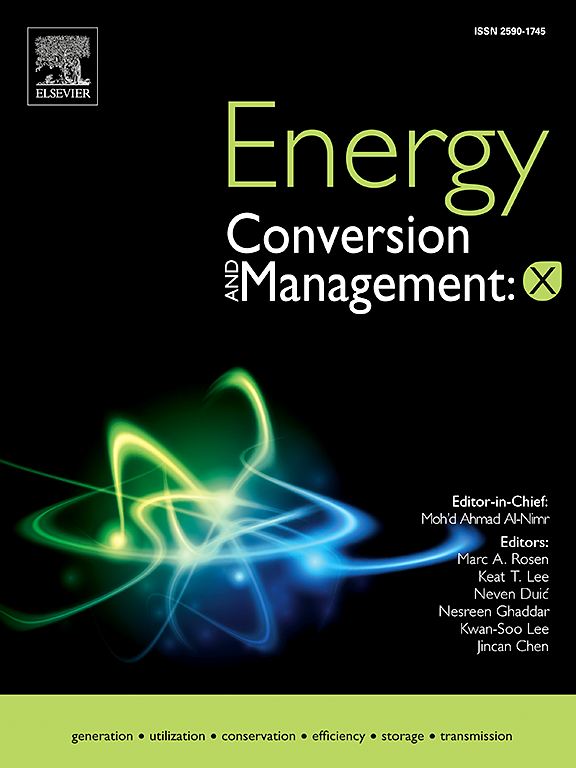Recycling of waste lubricant oil using two-step pyrolysis to produce fuel-like diesel and enhancing its combustion and emission parameters in diesel engines using linseed biodiesel
IF 7.1
Q1 ENERGY & FUELS
引用次数: 0
Abstract
The current study aimed to recycle waste lubricating oil (WLO) through a two-step electrical pyrolysis process and subsequently blended the produced fuel-like diesel (FLDR2) with linseed biodiesel (LSB) to enhance its combustion and emission characteristics. The experiment was divided into three phases. First, the electrical pyrolysis reactor was designed and implemented at the lab scale. In the second phase, the WLO was transferred to FLDR2 using the pyrolysis reactor in two rounds. In addition, linseed biodiesel (LSB) was prepared by using the same reactor with the aid of 1 % wt. NaOH as a catalyst. The physicochemical properties of FLDR1, FLDR2, and LSB were assessed by applying FTIR and TGA. In the pretest, fuel like-diesel produced from round-1, labeled FLDR1, was applied to the diesel engine, but it did not run smoothly. Finally, the combustion and pollutant features of pure FLDR2, LSB, and their 20 % and 30 % mixtures by volume of LSB and 80 % and 70 % of FLDR2, named B20 and B30, were assessed. The pyrolysis results indicated that the maximum yields for FLDR1, FLDR2, and LSB were approximately 82.5 %, 96.5 %, and 83.5 %, respectively. Two-step pyrolysis is an effective technique for producing fuel-like diesel with physicochemical properties comparable to those of diesel fuel, including a low sulfur content (0.24 wt%). The viscosity, density, and heating value of FLDR2 were 3.4 cSt, 834 kg/m3, and 42,948 kJ/kg, respectively. The engine performance analysis revealed a 39 % increase in smoke opacity and a 5 % increase in brake-specific fuel consumption for FLDR2 compared with diesel fuel. However, the B20 and B30 blends presented substantial reductions in smoke opacity, with average values of 32 % and 50 %, respectively, compared with those of pure FLDR2 and D100. These findings illustrated that blending LSB with FLDR2 significantly enhanced engine performance and demonstrated its potential as a viable alternative fuel for diesel engines, particularly the B30 blend, without requiring any engine modifications.

求助全文
约1分钟内获得全文
求助全文
来源期刊

Energy Conversion and Management-X
Multiple-
CiteScore
8.80
自引率
3.20%
发文量
180
审稿时长
58 days
期刊介绍:
Energy Conversion and Management: X is the open access extension of the reputable journal Energy Conversion and Management, serving as a platform for interdisciplinary research on a wide array of critical energy subjects. The journal is dedicated to publishing original contributions and in-depth technical review articles that present groundbreaking research on topics spanning energy generation, utilization, conversion, storage, transmission, conservation, management, and sustainability.
The scope of Energy Conversion and Management: X encompasses various forms of energy, including mechanical, thermal, nuclear, chemical, electromagnetic, magnetic, and electric energy. It addresses all known energy resources, highlighting both conventional sources like fossil fuels and nuclear power, as well as renewable resources such as solar, biomass, hydro, wind, geothermal, and ocean energy.
 求助内容:
求助内容: 应助结果提醒方式:
应助结果提醒方式:


